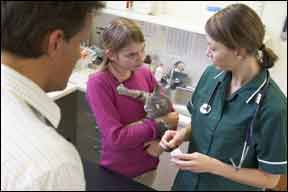Unfortunately, our beloved cats can face many ailments that develop as they age. Chronic renal disease is among the more serious of age-related conditions. It affects many older cats, but acute renal failure can be caused by other factors such as eating or drinking toxins, or

288
kidney infection.
Whatever the cause, chronic renal disease results from continued diminished kidney function. When her kidneys are failing, a cat will typically exhibit symptoms such as frequent urination coupled with excessive thirst, listlessness, loss of appetite, vomiting, weight loss and even vision problems. The kidneys filter the bodys blood supply by removing metabolic waste products and toxins. Those toxins and waste products are then excreted from the body through urine. In chronic renal disease, this filter has stopped working and these wastes have built up in the bloodstream.
Many Causes. If your cat drinks antifreeze, for example, she will suffer acute (total and sudden) renal failure, which is usually fatal. Chronic renal disease, in contrast, is caused by an age-related decline in kidney function or a chronic bacterial infection of the kidney called pyelonephritis. Left untreated, pyelonephritis can permanently damage the kidneys, resulting in diminished kidney function.
Its often difficult to trace the exact cause of chronic renal disease, and there is no readily correctable or reversible process that you can identity. Usually, the veterinarian tries to manage the disease by dietary adjustment and/or medication. Diagnosing chronic renal failure involves blood and urine tests, and observing the cat. Signs include urinating and drinking a lot, vomiting, inappetence and lethargy. Cats may also become anemic.
The symptoms of chronic renal disease can also be masked by other problems. For example, kidney failure or dysfunction can cause high blood pressure or hypertension. In some cases, untreated hypertension can cause eye damage or even blindness in cats.
Generally, one of the first steps a veterinarian will take in treating chronic renal failure is to modify the diet so that it is lower in protein. That is because waste products that are created by the digestion and metabolism of protein will build up in the blood of a cat with chronic renal failure. Another common treatment is to carefully inject fluids under the cats skin to help flush the kidneys. Both dietary changes and fluid administration can be very effective in maintaining your cats quality of life and also increasing her lifespan.
Another Option. Kidney transplants are also an option for cats with renal disease. These transplants are often used when a cat undergoes acute renal failure and for treating chronic renal disease that has progressed to the point where other treatments are no longer effective, explains James Flanders, DVM, associate professor of clinical sciences at Cornell Universitys College of Veterinary Medicine.
However, a kidney transplant is not the answer for all cats. Despite his illness, the cat must still be healthy enough to undergo the rigors of major surgery. “Surgery and anesthesia are stressful,” explains Dr. Flanders. Before surgery is approved, the veterinarian must perform a thorough examination to determine if the cat is strong enough to withstand surgery. They also screen for conditions that could cause complications, such as the feline leukemia virus (FeLV) or heart disease.
Where do veterinarians get the donor kidneys to transplant into your sick cat? In most cases, the owner of the cat receiving the transplant owns another cat who can be used as a donor, says Dr. Flanders. At large transplantation centers, donor cats are sometimes supplied by the center. However, the owner of the recipient cat must agree to adopt the donor cat.
Cat-kidney organ donors are easier to match than human organ donors. “In people, tissue matching is critical,” says Dr. Flanders. “But in cats, that isnt so important. The donor and recipient do have to be of the same blood type.”
Interestingly, surgeons will not remove the diseased kidney from the cat receiving the donor kidney. “We usually leave the recipients kidneys intact because they still perform some function, although it is diminished. So a cat getting a kidney transplant ends up with three kidneys,” explains Dr. Flanders.
A kidney transplant can add several years to your cats life. About 65 percent of cats undergoing a transplant survive their first year. Some cats have lived an additional five or six years after their transplants. Once a cat receives a kidney transplant, however, he must be given the drug cyclosporine or prednisolone for the rest of his life. Otherwise, his body will reject the new kidney.
Besides the risks and potential complications, a kidney transplant is expensive, and few veterinary facilities are capable of performing it. The total expenses – include screening tests, preoperative, donor adoption, the surgery for both cats, extended hospital care, postoperative maintenance, scales and lifelong medications – can range between $10,000 and $20,000.



